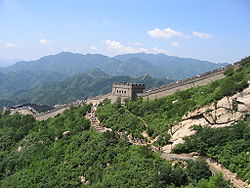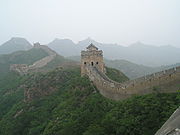
|
World LandMarks |
The Great Wall of China

The Great Wall of China (simplified Chinese: 长城; traditional Chinese: 長城; pinyin: Chángchéng; literally "Long City/fortress") or (simplified Chinese: 万里长城; traditional Chinese: 萬里長城; pinyin: Wànlǐ Chángchéng; literally "The long wall of 10,000 Li (里)") is a series of stone and earthen fortifications in China, built, rebuilt, and maintained between the 6th century BC and the 16th century to protect the northern borders of the Chinese Empire from Xiongnu attacks during the rule of successive dynasties. Several walls, referred to as the Great Wall of China, were built since the 5th century BC. The most famous is the wall built between 220–200 BC by the first Emperor of China, Qin Shi Huang; little of it remains; it was much farther north than the current wall, which was built during the Ming Dynasty.

The Great Wall stretches over approximately 6,400 km (4,000 miles) from
Shanhaiguan in the east to Lop Nur in the west, along an arc that roughly
delineates the southern edge of Inner Mongolia, but stretches to over 6,700 km
(4,160 miles) in total. At its peak, the Ming Wall was guarded by more than one
million men. It has been estimated that somewhere in the range of 2 to 3 million
Chinese died as part of the centuries-long project of building the wall.
Notable areas
The following three sections are in Beijing municipality, which were renovated
and which are regularly visited by modern tourists today.
"North Pass" of Juyongguan pass, known as the Badaling. When used by the Chinese
to protect their land, this section of the wall has had many guards to defend
China’s capital Beijing. Made of stone and bricks from the hills, this portion
of the Great Wall is 7.8 meters (25.6 ft) high and 5 meters (16.4 ft) wide.
"West Pass" of Jiayuguan_(pass). This fort is near the western edges of the
Great Wall.
"Pass" of Shanhaiguan. This fort is near the eastern edges of the Great Wall.
One of the most striking sections of the Ming Great Wall is where it climbs
extremely steep slopes. It runs 11 kilometers (7 mi) long, ranges from 5 to 8
meters (16–26 ft) in height, and 6 meters (19.7 ft) across the bottom, narrowing
up to 5 meters (16.4 ft) across the top. Wangjinglou is one of Jinshanling's 67
watchtowers, 980 meters (3,215 ft) above sea level.
South East of Jinshanling, is the Mutianyu Great Wall which winds along lofty,
cragged mountains from the southeast to the northwest for approximately 2.25
kilometers (about 1.3 miles). It is connected with Juyongguan Pass to the west
and Gubeikou to the east.
25 km west of the Liao Tian Ling stands of part of Great wall which is only 2~3
stories high. According to the records of Lin Tian, the wall was not only
extremely short compared to others, but it appears to be silver. Archeologists
explain that the wall appears to be silver because the stone they used were from
Shan Xi, where many mines are found. The stone contains extremely high metal in
it causing it to appear silver. However, due to years of decay of the Great
Wall, it is hard to see the silver part of the wall today.
Another notable section lies near the eastern extremity of the wall, where the
first pass of the Great Wall was built on the Shanhaiguan (known as the “Number
One Pass Under Heaven”), the first mountain the Great Wall climbs. Jia Shan is
also here, as is the Jiumenkou, which is the only portion of the wall that was
built as a bridge. Shanhaiguan Great Wall is called the “Museum of the
Construction of the Great Wall”, because of the Meng Jiang-Nu Temple, built
during the Song Dynasty.

